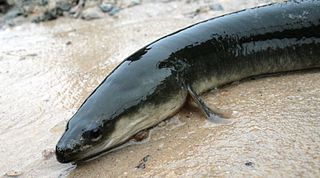
The American eel is a facultative catadromous fish found on the eastern coast of North America. Freshwater eels are fish belonging to the elopomorph superorder, a group of phylogenetically ancient teleosts. The American eel has a slender, supple, snake-like body that is covered with a mucus layer, which makes the eel appear to be naked and slimy despite the presence of minute scales. A long dorsal fin runs from the middle of the back and is continuous with a similar ventral fin. Pelvic fins are absent, and relatively small pectoral fins can be found near the midline, followed by the head and gill covers. Variations exist in coloration, from olive green, brown shading to greenish-yellow and light gray or white on the belly. Eels from clear water are often lighter than those from dark, tannic acid streams.

The red-backed salamander is a small, hardy woodland salamander species in the family Plethodontidae. It is also known as the redback salamander, eastern red-backed salamander, or the northern red-backed salamander to distinguish it from the southern red-backed salamander. The species inhabits wooded slopes in eastern North America, west to Missouri, south to North Carolina, and north from southern Quebec and the Maritime provinces in Canada to Minnesota. It is one of 56 species in the genus Plethodon. Red-backed salamanders are notable for their color polymorphism and primarily display two color morph varieties, which differ in physiology and anti-predator behavior.
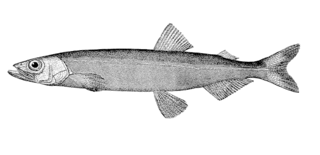
The capelin or caplin is a small forage fish of the smelt family found in the North Atlantic, North Pacific and Arctic oceans. In summer, it grazes on dense swarms of plankton at the edge of the ice shelf. Larger capelin also eat a great deal of krill and other crustaceans. Among others, whales, seals, Atlantic cod, Atlantic mackerel, squid and seabirds prey on capelin, in particular during the spawning season while the capelin migrate south. Capelin spawn on sand and gravel bottoms or sandy beaches at the age of two to six years. When spawning on beaches, capelin have an extremely high post-spawning mortality rate which, for males, is close to 100%. Males reach 20 cm (8 in) in length, while females are up to 25.2 cm (10 in) long. They are olive-coloured dorsally, shading to silver on sides. Males have a translucent ridge on both sides of their bodies. The ventral aspects of the males iridesce reddish at the time of spawn.

Mirocaris is a genus of shrimp associated with hydrothermal vents. Sometimes considered the only genus of the family Mirocarididae, Mirocaris is usually placed in the broader family Alvinocarididae. Mirocaris is characterized by a dorsoventrally flattened, non-dentate rostrum, as well as the possession of episodes on the third maxilliped through to the fourth pteropod. The genus contains two species, M. fortunata and M. indica. The two species are found in different oceans, and can be distinguished by the pattern of setation on the claw of the first pereiopod.

The shovelnose guitarfish, Rhinobatos productus, is a ray in the family Rhinobatidae. As its common name suggests, this species possesses a pointed shovel-shaped snout and a body similar to that of a guitar with a larger head and long, slender body. The shovelnose is considered to be a primitively developed ray, with many features of both sharks and rays. The shovelnose guitarfish was first considered to be a shark because of its dorsal fins' shape. The coloration of this species ranges from olive to sandy brown which aids in the species' ability to camouflage in the sand. Other identifying features of the R. productus include a depressed body shape with a dorsoventrally flattened opaque snout, no gap between the pectoral and pelvic fins, and protruding eyes. Also, this species has two dorsal fins closer to the posterior end of its body and caudal fin. Shovelnose guitarfish have around 102 to 112 small round teeth. Sexual maturity is reached in females at an estimated age of 8 years and 7 years in males.

Urosaurus ornatus, commonly known as the ornate tree lizard, is a species of lizard in the family Phrynosomatidae. The species is native to the southwestern United States and northwestern Mexico. The species, which was formerly called simply the "tree lizard", has been used to study physiological changes during the fight-or-flight response as related to stress and aggressive competition. Its life history and costs of reproduction have been documented in field populations in New Mexico and Arizona. This species has been fairly well studied because of its interesting variation in throat color in males that can correlate with different reproductive strategies,
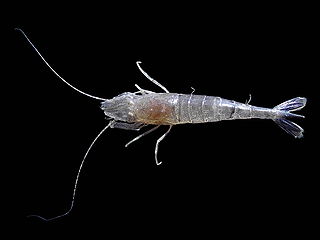
Crangon crangon is a species of caridean shrimp found across the northeastern Atlantic Ocean. Its range extends from the White Sea in the north of Russia to the coast of Morocco, including the Baltic Sea, and appears also throughout the Mediterranean and Black Seas. Commercially important, it is fished mainly in the southern North Sea. Common names include brown shrimp, common shrimp, bay shrimp, and sand shrimp, while translation of its French name crevette grise sometimes leads to the English version grey shrimp.

The longfin inshore squid is a species of squid of the family Loliginidae.
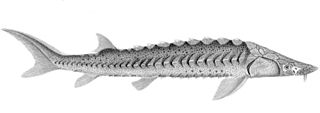
The green sturgeon is a species of sturgeon native to the northern Pacific Ocean, from China and Russia to Canada and the United States.

The yellow mud turtle, also commonly known as the yellow-necked mud turtle, is a species of mud turtle in the family Kinosternidae. The species is endemic to the Central United States and Mexico.

The bluntnose stingray or Say's stingray is a species of stingray in the family Dasyatidae, native to the coastal waters of the western Atlantic Ocean from the U.S. state of Massachusetts to Venezuela. It is a bottom-dwelling species that prefers sandy or muddy habitats 1–10 m (3.3–32.8 ft) deep, and is migratory in the northern portion of its range. Typically growing to 78 cm (31 in) across, the bluntnose stingray is characterized by a rhomboid pectoral fin disc with broadly rounded outer corners and an obtuse-angled snout. It has a whip-like tail with both an upper keel and a lower fin fold, and a line of small tubercles along the middle of its back.

Oratosquilla oratoria, the Japanese mantis shrimp, is a species of mantis shrimp found in the western Pacific. It is widely harvested in Japan and eaten as sushi. Like other members of its order it has a powerful spear, which it uses to hunt invertebrates and small fish. It grows to a length of 185 millimetres (7.3 in), and lives at depths of 10–100 metres (33–328 ft).

Geukensia demissa is a species of mussel, a marine bivalve mollusk in the family Mytilidae, the true mussels. This species is native to the Atlantic coast of North America. The common names for this species include ribbed mussel, Atlantic ribbed marsh mussel and ribbed horsemussel. However, the common name ribbed mussel is also used for the Southern Hemisphere mussel Aulacomya atra. The appearance of the shell is grooved and oval in shape. The interior of this mussel is tinted purple.
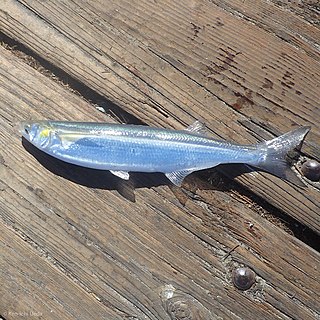
Atherinopsis californiensis, the jack silverside or jacksmelt, is a species of neotropical silverside native to the Pacific coast of North America from Oregon, United States to southern Baja California, Mexico. This species grows to 45 cm (18 in) in total length, silver throughout the body, grey dorsal pattern, light silver ventral-lateral. Yellow spot present behind the eye, on operculum. and is important commercially as a source of human food. It is the only known member of its genus.
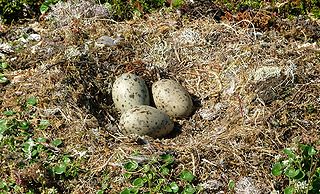
Clutch size refers to the number of eggs laid in a single brood by a nesting pair of birds. The numbers laid by a particular species in a given location are usually well defined by evolutionary trade-offs with many factors involved, including resource availability and energetic constraints. Several patterns of variation have been noted and the relationship between latitude and clutch size has been a topic of interest in avian reproduction and evolution. David Lack and R.E. Moreau were among the first to investigate the effect of latitude on the number of eggs per nest. Since Lack's first paper in the mid-1940s there has been extensive research on the pattern of increasing clutch size with increasing latitude. The proximate and ultimate causes for this pattern have been a subject of intense debate involving the development of ideas on group, individual, and gene-centric views of selection.
Eulimnadia texana, the Texas clam shrimp or desert shrimp, is a species belonging to the Limnadiidae family.
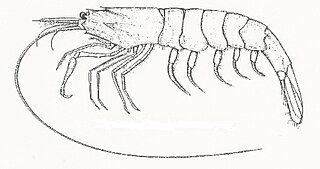
Crangon franciscorum is a species of shrimp in the family Crangonidae which is endemic to the brackish estuaries of California, and found from Puget Sound in the north to San Diego, California in the south. The species is especially abundant in San Francisco Bay, despite population fluctuations due to environmental stresses. Its common names include bay shrimp, sand shrimp, common shrimp, grass shrimp, black shrimp, California shrimp and black tailed shrimp. The species has been commercially fished from 1869 to the present.
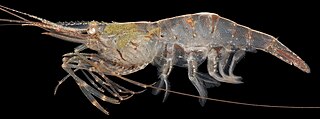
Palaemon macrodactylus is a species of shrimp of the family Palaemonidae.

Streblospio benedicti is a small polychaete native to the Western Atlantic, where its distribution ranges from the Gulf of Saint Lawrence to Venezuela. Sexual maturity is reached at around 9 to 14 weeks and populations and individuals may vary during development. It can be found in the mudflats and soft sediments of estuaries and coastal waters. Its general habitat includes oyster reefs, mangroves, grass beds, marinas, and docks while the tidal range where S. benedicti can be found is subtidal to intertidal. Additionally, S. benedicti can tolerate a broad range of temperatures and salinities. Due to its tolerance of high organic contents, S. benedicti is a pioneer organism of new habitats that it settles in. Furthermore, despite its small size, only reaching a maximum of 20 mm (0.79 in) in length, S. benedicti plays an important role in estuarine food webs as it can reach high population densities and is a substantial grazer of phytoplankton.
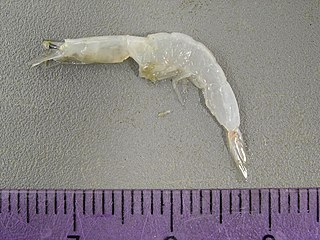
Acetes americanus is a small shrimp species in the family Sergestidae found in the western Atlantic Ocean between Brazil and the United States.



















